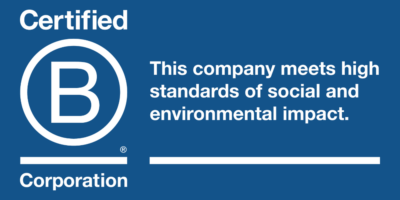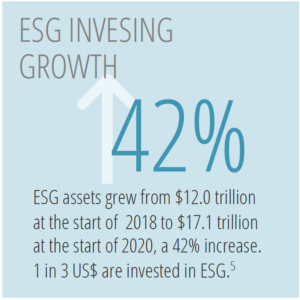Five Reasons Your Nonprofit Should Invest Sustainably
Leaders of nonprofit organizations spend exhaustive amounts of energy ensuring that the mission of their organization is fulfilled, and that their donor mandates are met. What many have not yet considered is how investing their endowments in socially responsible investments, also known as ESG (Environmental, Social and Governance) Investing, can further their organizations’ missions and better steward their donors’ dollars.
Responsible investing has been growing in popularity among a wide range of for-profit and not-for profit organizations. According to recent surveys, more than half of large foundation (75%) and endowment (63%) assets are currently allocated to environmental, social and governance (ESG) investments.1 The reasons for the growing popularity are many:
Why your nonprofit should invest in ESG?
1. Align your nonprofit’s investments with your mission.
Organizations can magnify their mission with values-based investing. Your nonprofit already makes required program-directed annual allocations of 5% of your assets in furtherance of your organization’s mission yet the other 95% can also work to advance the same goals and values. Investing in ESG can help ensure that your investments work in tandem with the good work you do every day.
2. ESG investing doesn’t mean performance is sacrificed.
A common myth is that ESG entails a kind of altruism; investors must accept lower returns to do good. But that’s consistently been proven false. A meta-analysis of more than 1,000 studies found ESG results in similar or better performance than non-ESG approaches—and potentially valuable downside protection, especially during social or economic crises.2
That conclusion was borne out in the volatility of 2020 when sustainable equity funds outperformed their non-ESG peers by a median total return of 4.3 percent, according to a study by the Morgan Stanley Institute for Sustainable Investing. Across both stocks and bonds, funds focused on ESG factors weathered the year better than non-ESG portfolios.3

3. Attract and retain donors, employees and volunteers.
Investing consistent with your values can be a tie-breaker issue for donors, and a draw for employees and volunteers. As people become more attuned to issues like climate change, racial injustice, as well as economic and health disparities, they are starting to look for ways to be a part of the solution, whether through their philanthropy or time.
4. Your future donors will expect it.
These issues are especially important to the next generation. Millennials, who are poised to receive the largest generational wealth transfer in history, clearly favor organizations that prioritize purpose. 70% of Gen X and 85% of millennials say that social or environmental impact is important to their investment decisions…and nearly half (49%) of baby boomers agree. 4
5. It’s the right thing to do.
Investing in ESG may be the most effective way an organization can support not only its own best interests, but also those of the world. Today, as social injustice, climate change, corruption and other issues become more urgent, you can be part of the solution by helping further the efforts of companies who value and protect people, planet, and profit.
How to get started
Due in part to the surging popularity of ESG investing, more portfolio managers are starting to add “ESG” to their fund names—even if they don’t truly merit the term. Some factors to consider when interviewing ESG managers:
- Do they use objective, third-party criteria for responsible investing such as that set by the UN PRI? The UN Principles for Responsible Investment (PRI) is generally considered a best-practices framework for evaluating managers.
- How ingrained is ESG into the firm’s culture and process? Some firms may apply an ESG screen or two, while others make ESG criteria an integral part of the investment analysis. Some firms relegate ESG to low-level employees, others make it a priority at the highest levels of management.
- How long have they been investing in ESG and why? Understand the firm’s backstory. Some companies jumped in because it’s popular, others have an intrinsic “why” that drives their decisions.
Even if your donors aren’t asking you today about how your assets are invested, chances are that they will start soon. Be sure you are prepared when that time comes. For more information about supporting your objectives through ESG investing, please contact Matt Drvaric.









